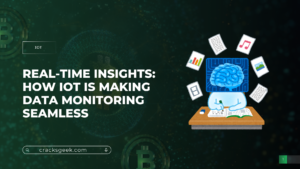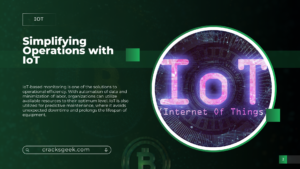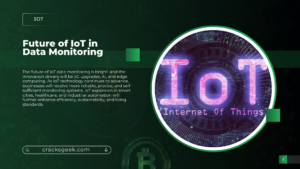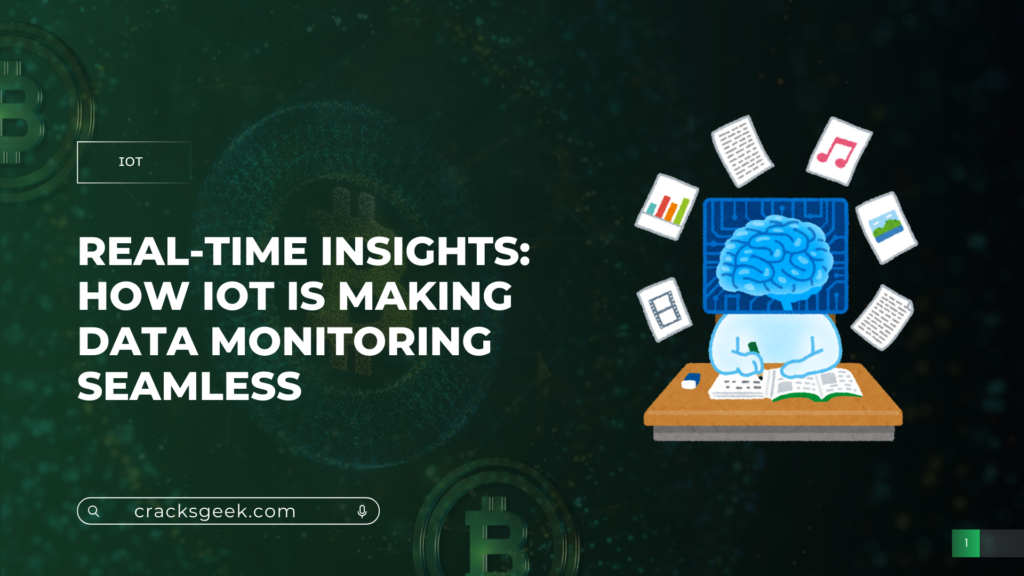
IoT is revolutionizing the monitoring of data, processing, and reacting to it in business and industry. IoT devices are making organizations efficient, data-driven, and react accordingly to operational issues by giving real-time insights. In this, the author describes how IoT is transforming the data monitoring in a manner it becomes seamless and continuous across industries.
1. Defining IoT in Data Monitoring
IoT refers to an internet network of devices that gather and share data. The devices, ranging from sensors to processors and connectivity modules, gather data in real time from the physical environment. By means of monitoring data, IoT enables organizations to track KPIs, detect anomalies, and trigger processes in motion automatically without the need for human intervention.
By leveraging IoT for monitoring data, organizations can shift from reactive and legacy to proactive and predictive. It decreases response time, enhances accuracy, and reduces the cost of operations. Since it is easy to integrate with existing infrastructure, IoT-based monitoring systems give a comprehensive view of processes, and this leads to data-driven decision-making.
2. Real-Time Data Collection and Transmission
IoT can receive and deliver data in real-time. IoT sensors collect data from assets, equipment, or environmental sensors in real-time and send it to a central system for analysis. This is extremely important to businesses such as manufacturing, health, logistics, and smart cities where real-time data are the major driving force in being able to work at optimum level.
Real-time data gathering removes delays and offers immediate response to emergencies. In manufacturing, for example, IoT sensors monitor equipment temperature changes and alert operators before equipment failure. In the medical field too, wearable IoT sensors monitor vital signs and alert medical staff to any deviation, enabling prompt medical intervention.
3. Simplifying Operations with IoT

IoT-based monitoring is one of the solutions to operational efficiency. With automation of data and minimization of labor, organizations can utilize available resources to their optimum level. IoT is also utilized for predictive maintenance, where it avoids unexpected downtime and prolongs the lifespan of equipment.
For example, in the energy industry, IoT-enabled smart grids track actual power usage in real time, balancing load management and reducing losses. In logistics, shipments are tracked by IoT sensors, temperature-controlled products are tracked, and positions are reported in real time, among others that supply chain optimization is utilized for. All these add cost savings but also increase productivity.
4. Predictive Analytics and Integration with AI
Combining predictive analytics and AI with IoT also optimizes data monitoring to its fullest extent. The IoT data is processed by AI algorithms with a view to find trends, patterns, and probable areas of risk. Predictive analytics assist enterprises in being able to forecast issues before they arise, hence ensuring that one can keep everything on track beforehand and make informed decisions.
In the case of production in a factory, IoT sensors track the machines, and AI predictive analysis gives signals about when a part would fail. Maintenance staff plan maintenance well ahead of time to prevent costly downtime. In farming as well, IoT sensors track the soil moisture, and AI suggests the optimal time to irrigate to achieve maximum yield.
5. Improved Safety and Security Measures
IoT data monitoring enhances safety and security across most industries. Industrial IoT sensors monitor hazardous situations such as gas leaks, overheat, or toxic material, making workers safe. Threats are detected in real-time with the help of smart surveillance cameras and IoT sensors, prompting security personnel to act in a timely fashion.
Apart from this, IoT-based monitoring sensors monitor the usage of the network and recognize unusual patterns indicating cyber attacks. By sensing them instantly, organizations can stop security breaches and protect sensitive data. Such surveillance is crucial to companies that are engaged in sensitive information and infrastructure.
6. Challenges and Considerations in IoT Data Monitoring
Although it is advantageous, IoT data monitoring is not disadvantageous in terms of data privacy issues, network exposure, and need for scalable infrastructure. Companies need to ensure they possess good cybersecurity so that there will be no hacking of IoT devices and data loss. It is not an easy process to implement it with already existing systems and does not occur without planning either.
Yet another is coping with the vast amount of data from IoT devices. There is a need for effective data handling, storage, and analysis to derive insights of value without overwhelming IT infrastructures. Cloud computing and edge computing solve these by enabling effective data management and minimizing latency.
7. Future of IoT in Data Monitoring

The future of IoT data monitoring is bright, and the innovation drivers will be 5G upgrades, AI, and edge computing. As IoT technology continues to advance, businesses will receive more reliable, precise, and self-sufficient monitoring systems. IoT expansion in smart cities, healthcare, and industrial automation will further enhance efficiency, sustainability, and living standards.
Apart from this, with amplification using AI, IoT devices will yield more detailed information and precise prediction, and business will be able to make intelligent decisions. Limitless innovation of security measures and data management systems will also decrease privacy concerns, and IoT adoption will be ethical and secure.
Conclusion
IoT-data monitoring is transforming businesses using real-time data, efficiency, and security. From predictive maintenance of the plant in manufacturing to patient monitoring in healthcare, IoT facilitates communication through data, keeping threats low and processes optimal. With some issues like data management and security pending, there are promising prospects for IoT technology in monitoring data with opportunities for improvement and networked operations in sectors.
Through the adoption of IoT technology, businesses and organizations are able to stay ahead of innovations, as real-time data triggers innovation and development. With continued advancements in IoT, its effect on data monitoring will be even more profound, shaping how we process, gather, and act upon data in the digital economy.





